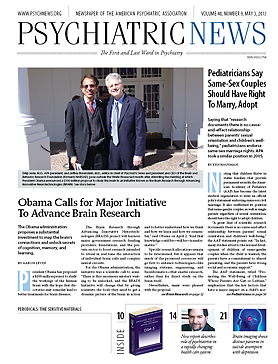Important conceptual changes to the chapter on paraphilic disorders will appear in DSM-5, though there are few alterations of the criteria.
Most apparent to clinicians will be the distinction between paraphilias—defined as atypical sexual practices—and paraphilic disorders, which include distress or impairment in functioning. Specific criteria for paraphilic disorders are not changed except for the addition of specifiers for “in remission” or “in a controlled environment” to indicate course of illness; the latter specifier would be used, for instance, in the case of someone with a pedophilic disorder who no longer engages in sexual activity with children because the individual is incarcerated.
Sub-work-group chair Ray Blanchard, Ph.D., told Psychiatric News that the distinction within the chapter between “paraphilias” and “paraphilic disorders” is a crucial one acknowledging that many people engage in atypical sexual practices, or paraphilias. Blanchard explained that a paraphilia is a necessary but not a sufficient condition for having a paraphilic disorder, and a paraphilia by itself does not automatically justify or require clinical intervention; in fact, a paraphilia is not a “diagnosis.”
To warrant the diagnosis of paraphilic disorder, an individual must meet criterion A and criterion B, the latter indicating that the paraphilia causes distress or impairment in functioning or that the sexual practice inherently involves nonconsenting individuals.
Blanchard said the distinction corrects what he called “a logical absurdity” in the DSM-IV criteria. “The previous criteria require that a person having a paraphilia be in distress,” he said. “So if you think about it, according to the criteria the only transvestite is an unhappy transvestite. You could have a man who cross-dresses for sexual gratification three times a week, but if he’s not unhappy about it, he’s not a transvestite.
“The change to the manual recognizes that you could practice sexual masochism or cross-dressing without having a mental disorder,” he said. “The two routes to upgrading a paraphilia to a paraphilic disorder are either because it causes distress or impairment in functioning or because the paraphilia inherently involves individuals who are nonconsenting and who have been used to gratifying the paraphilia in real life and not just in fantasy.”Important conceptual changes to the chapter on paraphilic disorders will appear in the new DSM-5, to be published this month, though there are few alterations of the actual criteria themselves.
Most apparent to clinicians will be the distinction between paraphilias—defined as atypical sexual practices—and paraphilic disorders, which include distress or impairment in functioning. Specific criteria for paraphilic disorders are not changed except for the addition of specifiers for “in remission” or “in a controlled environment” to indicate course of illness; the latter specifier would be used, for instance, in the case of someone with a pedophilic disorder who no longer engages in sexual activity with children because the individual is incarcerated.
Sub-work-group chair Ray Blanchard, Ph.D., told Psychiatric News that the separate distinction within the chapter of “paraphilias” and “paraphilic disorders” is a crucial one acknowledging that many people engage in atypical sexual practices, or paraphilias. Blanchard explained that a paraphilia is a necessary but not a sufficient condition for having a paraphilic disorder, and a paraphilia by itself does not automatically justify or require clinical intervention; in fact, a paraphilia is not a “diagnosis.”
To warrant the diagnosis of paraphilic disorder, an individual must meet criteria A and criteria B, the latter indicating that the paraphilia causes distress or impairment in functioning or that the sexual practice inherently involves nonconsenting individuals.
Blanchard said the distinction corrects what he called “a logical absurdity” in the DSM-IV criteria. “The previous criteria require that a person having a paraphilia be in distress,” he said. “So if you think about it, according to the criteria the only transvestite is an unhappy transvestite. You could have a man who cross-dresses for sexual gratification three times a week, but if he’s not unhappy about it, he’s not a transvestite.
“The change to the manual recognizes that you could practice sexual masochism or cross-dressing without having a mental disorder,” he said. “The two routes to upgrading a paraphilia to a paraphilic disorder are either because it causes distress or impairment in functioning or because the paraphilia inherently involves individuals who are nonconsenting and who have been used to gratifying the paraphilia in real life and not just in fantasy.” ■
